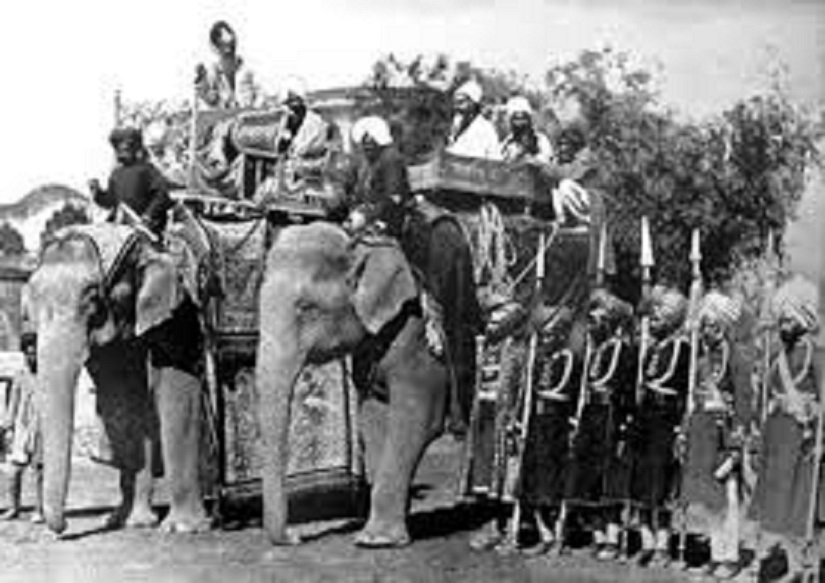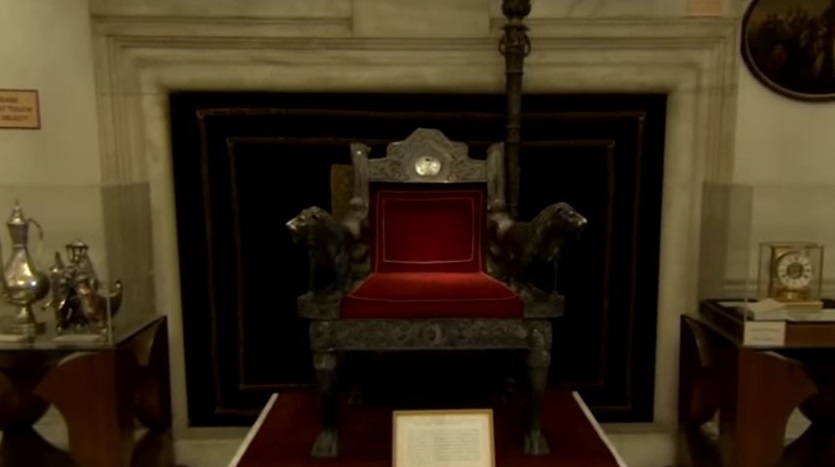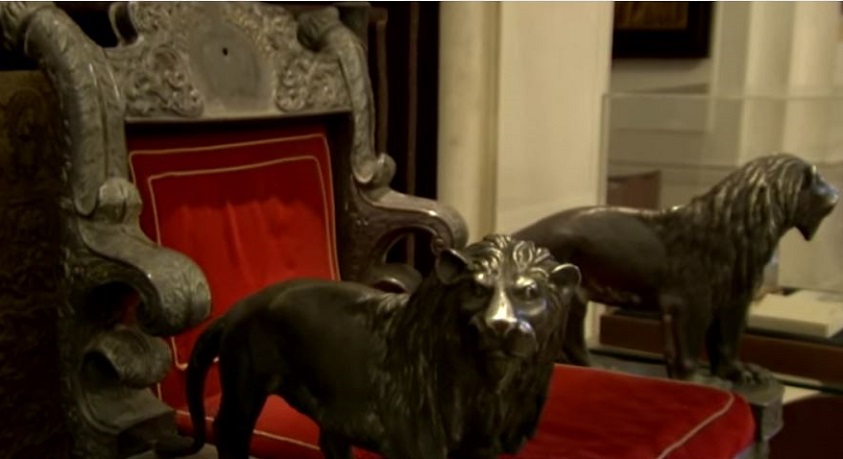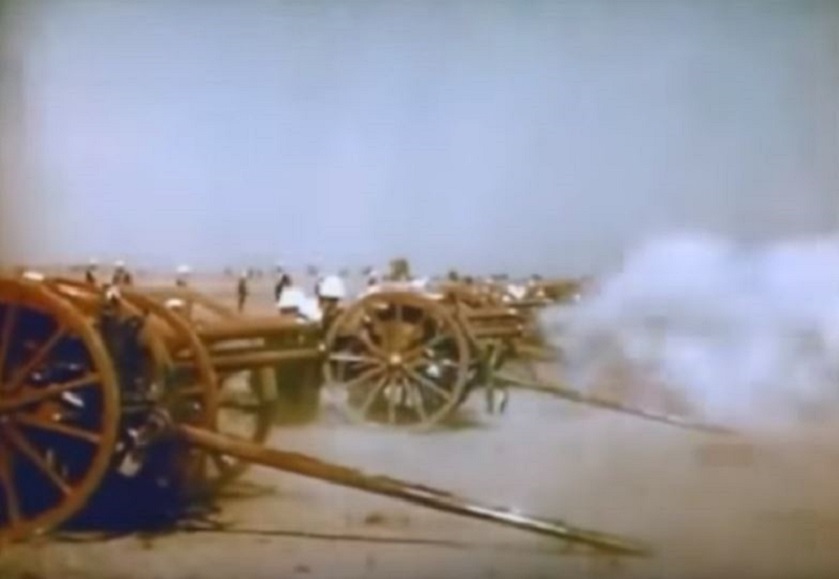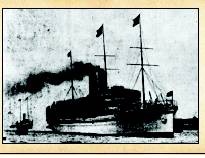The Delhi Durbar
This is a newspaper article selected for the excellence of its content. |
Contents |
Capital shift coronation
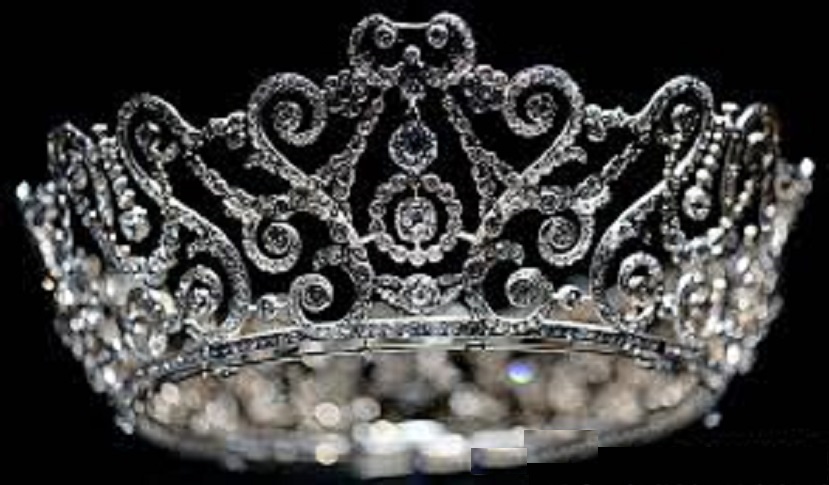
94 years later James Burleigh would write in an article, sarcastically titled ‘'Queen' Camilla wears Delhi Durbar tiara,’ for The Telegraph
“The Duchess of Cornwall [Camilla Parker Bowles] arrived at Buckingham Palace last night wearing her first royal tiara.
The diamond head piece, loaned to her by the Queen, was the tiara previously worn by Queen Mary for the Delhi Durbar to celebrate the coronation of King George V.
It was last worn in 1947 by the Queen Mother for an official visit to South Africa.
The circle of brilliant-cut diamonds mounted in gold and set in platinum was made by Garrards in 1911 and Queen Mary wore it in Delhi to mark the start of King George V's reign as King and Emperor of India.
The tiara previously included five of the Cambridge cabochon emeralds and also was occasionally worn with two diamonds from the Cullinan stone. But the emeralds were removed by Queen Mary and made into another tiara now owned by the Queen - the diamonds were kept separately as a brooch.”
King George V announced the Capital shift from Calcutta to Delhi at the 1911 durbar. Sidhartha Roy, Nivedita Khandekar, Manoj Sharma report. Durbar Notes
On the chilly but clear morning of December 12,1911, Delhiites made a beeline for a maidan near Burari to witness the biggest tamasha of the British Raj — the Delhi Durbar.
Before 1911, Delhi had hosted two durbars, in 1877 and 1903, to commemorate the coronation of ruling British monarchs. The first time a reigning King attended the coronation durbar was in 1911. The event, however, became historic for another important reason.
It was here that King George V announced the shifting of the capital of India from Calcutta to Delhi, a decision known only in the top echelons of the British regime till then.
Back then, Delhi was a modest commercial provincial town. It had been gifted to Punjab by the British for the latter’s support during the 1857 mutiny, its glorious Mughal past forgotten. The shifting of the capital put Delhi back on India’s political map and changed the course of its history. British India’s imperial capital today remains the political nerve centre of the country.
The Durbar : The durbar arrangements started a year in advance. The site for the durbar was in northwest Delhi— where the previous two durbars had been held. A city of tents came up across 25 square miles, sprawling from present day Civil Lines to Timarpur, Jahangirpuri, Shalimar Bagh, Ashok Vihar, Model Town and Shakurpur.
At the centre of the camp was the King’s pavilion, spread over 85 acres. Camps of officials and Indian princes were located in order of precedence. The camp had its own railway, connecting it to the amphitheatre where the durbar was held. Sixty four kms of new roads and 80 kms long water mains were constructed.
On December 12, the royal couple reached the amphitheatre in an open carriage and were seated inside an elaborate two-tier shamiana. The ceremonies included a 101-gun salute, parades, obeisance by rulers of princely states, distribution of medals to military officials and the proclamation.
The long task of building an imperial city from scratch began after the King left. Twenty years of frenetic construction later, New Delhi was unveiled.
Coronation Park to cricket pitch
As parks go, the Coronation Park in Delhi has a unique history to it—a history not known to the city’s common man, yet entrenched in the stone statutes that dot the park.
On December 11, 1911, the coronation ceremony of King George V and Queen Mary took place here amid much fanfare and was witnessed by thousands.
Today, the same park in north Delhi’s Burari has become a cricket playground for children blissfully unaware that this was where the King had announced at the elaborate durbar the plan to shift India’s capital from Calcutta to Delhi. Four days later, on December 15, he had laid the new capital’s foundation stone.
“Although they (British) intended to build the capital city there, the site was later rejected. A major reason was that the place was swampy, malaria-infested,” says AGK Menon, Delhi chapter head, Indian National Trust for Arts and Cultural Heritage (INTACH).
The park was recently in the news for the fact that during the Congress plenary session at Burari, PM Manmohan Singh and UPA chairperson Sonia Gandhi’s helicopters had landed at the spot where thousands had witnessed the coronation ceremony.
For years after Independence, the place was occupied by paramilitary forces and later used for political/religious congregations. Sometime in the early 1970s, King George V’s statue was brought here from India Gate. A coronation pillar, too, was built later.
All that remains today is a tall obelisk atop a crumbling platform near an enclosed shabbily maintained garden with broken statues on pedestals.
But thankfully, ahead of the 100th anniversary of the Delhi Durbar, the Delhi Development Authority (DDA), in charge of the park, has roped in INTACH for the park’s redevelopment.
The development plan includes: conservation and rearrangement of the statues at the commemorative zone, an interpretation centre amid landscaped garden and a forest area. “The park will be refurbished before December 2011,” said a senior DDA official.
A throne for the King
The thrones used by King George V and Queen Mary during the 1911 Delhi Durbar are on display separately at Marble Hall Gallery and the Gifts’ museum at Rashtrapati Bhavan. While the King’s chair, made of silver, weighs about 640 kg, that of the queen, also made of silver, weighs about 540 kg. These chairs were designed specially for the durbar by Calcutta-based firm H.M. Mint. The company’s name is inscribed on the throne of George V.
The thrones also have the names of both the King and the Queen and date of Delhi Durbar inscribed on them. “The art section of the President’s Secretariat has a professional conservator who preserves the chairs. Their original colours have been retained,” says Archana Datta, OSD (PR) to President of India.
But the conservation of these thrones is quite a task. “Every time we need to take these chairs to the conservation laboratory at the Rashtrapati Bhavan, we need a dozen people to lift them. We also have a special trolley to carry them,” says KK Sharma, deputy director, arts, president’s secretariat. Sharma says these chair were used by Indian Presidents till the 1960 at ceremonies held to receive credentials of foreign envoys. “But the queen’s chair has never been used,” adds Sharma.
Apart from the Thrones, the Marble hall Gallery also has a model of the Crown of King George V that dates back to 1930. It was made by Nannai Mall Contractor as inscribed on crown with date 10. 10. 1930. “Made of brass, it weighs about 200 kgs,” says Sharma.
The Delhi Durbar
From the archives of the The Times of India OCTOBER 25 | 1911 onwards
The Delhi Durbar was among the momentous events of British India. The Times of India captured the event in delightful details
The glamorous event had far-reaching significance. Supposedly held to commemorate the coronation in London of King George V and Queen Mary and proclaim them sovereigns of India, the splendorous show threw up surprises. Without warning, the King declared moving of the capital of imperial India from Calcutta to Delhi. He annulled the 1905 partition of Bengal. The Bengali-speaking areas were consolidated and borders of eastern India redrawn. The state of Bihar was born, its capital in Patna.
Times of India’s December 13 edition gushed: “The scene at Delhi yesterday, when his Imperial Majesty, the King Emperor announced in person the solemn rite of his coronation to his Indian people, was one of unsurpassed dignity and splendour.” In a news item painted in bold brushstrokes of colour, the daily described how: “Indian sovereigns and thousands of His Majesty’s loyal subjects witnessed a spectacle the like of which has never before been seen.”
The sovereigns appeared in their coronation robes, the kingemperor wearing the bejeweled Imperial Crown of India studded with 6,170 diamonds, sapphires, emeralds and rubies. So heavy was the crown that it reportedly gave the king a headache.
An earlier sequence of news reports detailed the meticulous preparations for the grand event. The durbar camp, specially constructed for the occasion, spread over 25 sq miles and had its own railway. Sixty-four km of new roads were built. A Shimla-datelined story carried a long list of camps to be set up for the durbar in Delhi, key British officials who’d attend, public works, roads to be spruced up or built and an unending list of Indian royals who’d be present. Other than the biggies, this mentioned relatively obscure, smaller princes and there were more than 500 of them.
On the sidelines, the imperial government organised football and hockey tournaments to celebrate the occasion.
A June 13 report in TOI quotes an official letter thus: “There will be in connection with the coronation durbar football and hockey tournaments open to the British and Indian armies, respectively, for cups presented by HM the King.” On sartorial matters too, the Raj government had a lot to say. TOI mentioned a government decision to fix dresses for judges.
“The government of India has been in communication with the court authorities about the dresses of the judges of various high and chief courts with a view to restore uniformity in judicial court dresses at the Delhi Durbar.”
After the build-up coverage, the actual durbar report started descriptively and switched to an analytical tenor explaining the import of the decisions announced by George V. “With this wonderfully impressive spectacle (of the coronation durbar) fresh in our imagination, we come to the announcements made by His Majesty at the close of the ceremony.” The first “dramatic” announcement related to the “change of the seat of government from Calcutta to Delhi” and “readjustment of the province of Bengal”.
“The King announced that the great city which had been the headquarters of government ever since British rule in India was to be abandoned in favour of the ancient capital of the Moghuls and a former seat of Hindu power. The King declared the remodelling of the administrative boundaries of East India,” the paper recorded.
Calling the shift of capital progressive and an administrative necessity, the TOI report said “judged on merit”, the decision had “universal support”.
The previous arrangement, it said, was impracticable and that the government of India can’t be associated with any particular provincial government. “The location of government of India in Calcutta for many months of the year kills provincial independence in Bengal... renders the Imperial government... in a manner both unjust and unworkable. The case for the removal of the government of India from Calcutta is overwhelming and urgent...”
Delhi, the report says, is most suitable as the seat of imperial government. “It is well served by the railway, its climate is good for seven months and it embraces every facility necessary for the creation of a great imperial city.” Three days after the announcement about shifting the capital, the fo u n d at i o n stone for New Delhi was laid at Coronation Park, E dw a rd L u t ye n s given the task of designing the capital.
CORONATION OR DURBAR?
Sir, At the Town Hall meeting on Thursday the High Sheriff seems to have referred several times to the “Coronation” of Their Majesties at Delhi... Is not the coronation of the King of the United Kingdom an exclusively Christian ceremony requiring exclusively Christian Ministers to perform it? Is the ceremony repeatable any more than a Christian baptism or Christian marriage is repeatable? If there is to be a crowning of some kind or other at Delhi, who is to place the crown on the King’s Head? Is it not more correct and therefore more desirable to describe the Delhi ceremony as a Proclamation Durbar. —Letter to the editor by one Rose Dartle
DURBAR BOSSMAN’S PERKS & PRIVILEGES
Sir John Hewett was president of the Delhi Coronation Durbar Committee. Times of India reported that he was allowed a private secretary and aide de camp. He was given a house in Simla (then summer capital of the British Raj), although “he will pay constant visits to Delhi”.
District dos
In the districts, durbars were held in several places. A large gathering of native chiefs, officers of the agency, and leading residents was held in Mahi Kantha. In Dharwar, a sports meet was held. Ajmer hosted a gathering at the Marwaras Regimental Maidan. Baroda had a holiday.
Medal mania
There were reports that 5,000 additional medals were distributed arbitrarily. The press sought a probe. “We learn that by order of the governor-general the original 5,000 medals set aside for the military are to be increased by another 5,000... But the medals to ladies, to visitors and to sundry clerks still remains to be explained”.
Viceroy loses train
The viceroy’s special train was renovated and upholstered for use of the King George V and Queen Mary. Interestingly, another railway company known as E B S Railway, managed to provide a special train for the use of the viceroy.
Definitely in tents
TOI reported thus: It has been definitely decided that their Majesties, during their visit to Delhi, will reside in tents and not in a house. All the camps will be arranged on a uniform plan so as to produce the best spectacular effect instead of allowing each tent to be arranged independently of the rest.
No Ribbon cutting
The British government actually issued a press release that said: “We are informed that owing to shortness of his stay in India, His Majesty the king regrets that he will not be able to accept invitations to perform functions such as the laying of the foundation stones of public buildings, opening of hospitals etc”.
Shown the door
The Maharaja of Kashmir presented the king emperor splendid walnut carved doorways and panels, which he so admired in the Kashmir camp at the Delhi Durbar. George V accepted the Kashmiri gifts and the carvings were packed for shipment to London, TOI reported
See also
Delhi: the Battle of Delhi, 1803
Delhi/ New Delhi: A history, Dec. 1911- Aug. 1947
The Delhi Durbar
